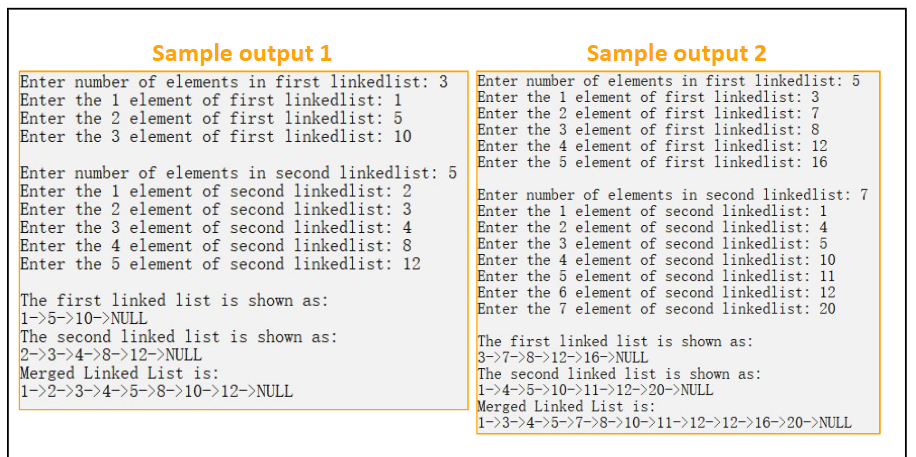Write a function that takes two call-by-reference arguments that are pointer variables that point to the heads of linked lists of values of type int. The two linked lists are assumed to be sorted so that the number at the head is the smallest number, the number in the next node is the next smallest, and so forth. The function returns a pointer to the head of a new linked list that contains all of the nodes in the original two lists.
Write a function that takes two call-by-reference arguments that are pointer variables that point to the heads of linked lists of values of type int. The two linked lists are assumed to be sorted so that the number at the head is the smallest number, the number in the next node is the next smallest, and so forth. The function returns a pointer to the head of a new linked list that contains all of the nodes in the original two lists.
C++ Programming: From Problem Analysis to Program Design
8th Edition
ISBN:9781337102087
Author:D. S. Malik
Publisher:D. S. Malik
Chapter17: Linked Lists
Section: Chapter Questions
Problem 18PE
Related questions
Question
Use C++
no arrays, no sorting

Transcribed Image Text:◆Write a function that takes two call-by-reference arguments that are
pointer variables that point to the heads of linked lists of values of type
int. The two linked lists are assumed to be sorted so that the number at
the head is the smallest number, the number in the next node is the next
smallest, and so forth. The function returns a pointer to the head of a new
linked list that contains all of the nodes in the original two lists.

Transcribed Image Text:Sample output 1
Enter number of elements in first linkedlist: 3
Enter the 1 element of first linkedlist: 1
Enter the 2 element of first linkedlist: 5
Enter the 3 element of first linkedlist: 10
Enter number of elements in second linkedlist: 5
Enter the 1 element of second linkedlist: 2
Enter the 2 element of second linkedlist: 3
Enter the 3 element of second linkedlist: 4
Enter the 4 element of second linkedlist: 8
Enter the 5 element of second linkedlist: 12
The first linked list is shown as:
1->5->10->NULL
The second linked list is shown as:
2-3-4->8->12->NULL
Merged Linked List is:
1->2->3->4->5->8->10->12-> NULL
Sample output 2
Enter number of elements in first linkedlist: 5
Enter the 1 element of first linkedlist: 3
Enter the 2 element of first linkedlist: 7
Enter the 3 element of first linkedlist: 8
Enter the 4 element of first linkedlist: 12
Enter the 5 element of first linkedlist: 16
Enter number of elements in second linkedlist: 7
Enter the 1 element of second linkedlist: 1
Enter the 2 element of second linkedlist: 4
Enter the 3 element of second linkedlist: 5
Enter the 4 element of second linkedlist: 10
Enter the 5 element of second linkedlist: 11
Enter the 6 element of second linkedlist: 12
Enter the 7 element of second linkedlist: 20
The first linked list is shown as:
3->7->8->12->16-> NULL
The second linked list is shown as:
1->4->5->10->11->12->20->NULL
Merged Linked List is:
1->3->4->5->7->8->10->11->12->12->16->20->NULL
Expert Solution
This question has been solved!
Explore an expertly crafted, step-by-step solution for a thorough understanding of key concepts.
This is a popular solution!
Trending now
This is a popular solution!
Step by step
Solved in 4 steps with 6 images

Knowledge Booster
Learn more about
Need a deep-dive on the concept behind this application? Look no further. Learn more about this topic, computer-science and related others by exploring similar questions and additional content below.Recommended textbooks for you

C++ Programming: From Problem Analysis to Program…
Computer Science
ISBN:
9781337102087
Author:
D. S. Malik
Publisher:
Cengage Learning

C++ Programming: From Problem Analysis to Program…
Computer Science
ISBN:
9781337102087
Author:
D. S. Malik
Publisher:
Cengage Learning